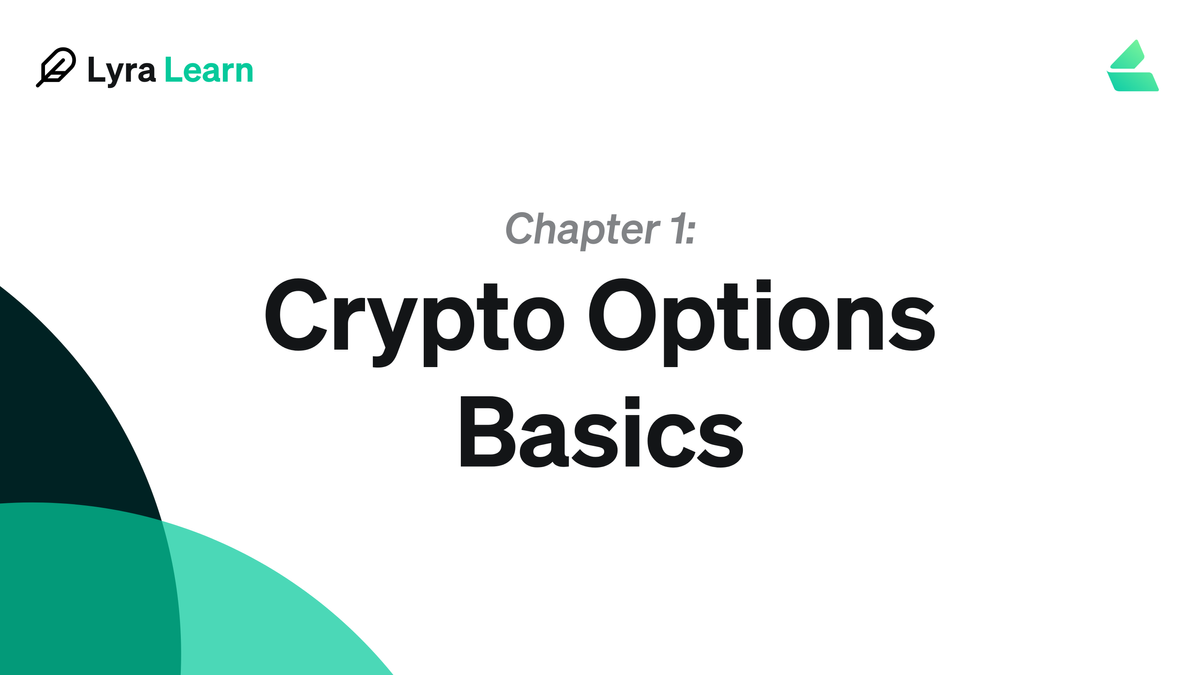Crypto Options Basics

Options are one of the most versatile and composable primitives in finance. As of now they remain one of the most underutilized tools in DeFi. At Lyra we believe that this will be short lived, and crypto options markets will reach the tremendous scale currently seen in traditional finance.
This is the first chapter of an 8-part educational series with an objective to upskill the Lyra community to become more confident and well versed options traders. This series will start with an assumption that the reader has never heard of options before and by the end, even the most beginner trader should be comfortable using the Lyra trading platform. Lyra is an options trading platform that allows users to buy and sell European options against a liquidity pool, read more about the Lyra protocol here.
Chapter 1: Crypto Options Basics will cover:
- What are options?
- Why trade options?
- Types of options
- Who trades options?
- Risks
The purpose of this blog is not to provide traders with strategies to operate effectively but rather form a solid foundation of knowledge which can be used to make intelligent and profitable trading decisions in the future. Later chapters of this course will provide an in depth dive into options strategy with real life examples.
What are options?
Options are a tool that allow you to trade the future value of a market. Options are a derivative of an underlying instrument that give you the right but not the obligation to make a trade at a set price, at a set date in the future. Think of it like an agreement between two people, Hayden pays Sergey a $200 premium to buy an ‘option contract’ today on the agreement that Sergey will sell Hayden 1 ETH at $3500 in two weeks (the strike price):
- If the price of ETH increases to $5000, Sergey is obliged to sell Hayden 1 ETH for $3500 and keep the difference
- If the price of ETH falls to $2000 and doesn’t recover before that date, the option Hayden purchased is worthless and Sergey gets to keep the $200 premium.
To best explain the dynamics of options trading, let's look at this example with two outcomes. The dark blue line represents a price chart of ETH.
Outcome 1: In the money
During the two weeks before the option expires, the price of ETH bounces around between $2500 and $3400 until it eventually breaks above $3500. Any amount above the $3500 strike price is profit to Hayden (less the $200 premium paid for the option). In the scenario below, Hayden’s option has closed above the strike price and is therefore in the money.
Outcome 2: Out of the money
In the two weeks agreed by Hayden and Sergey, the price of ETH fluctuated significantly but never went above the agreed $3500 and more importantly, is not above the strike price at the time of expiry. Because Hayden is out of the money at the time of expiry, his option is worthless and Sergey gets to keep the $200 premium.
Another consideration is that if the price of ETH went above $3500 at any point of time, Hayden could close his position and sell the call option back to Sergey to realize his profits. In the case of Lyra, the trader would sell their position back to the liquidity pool (not needing to find another trader to fill the order). This ability to close option positions before expiry is a powerful feature of the Lyra mechanism.
Options provide leverage. By buying options you’re paying significantly less for the premium than it would cost to hold the equivalent position in the underlying asset, profiting from a token’s price movement without committing substantial capital. This makes a powerful tool for traders, but also comes with a series of risks which we will talk about later in this blog.
Why trade options?
Options are versatile tools that allow traders to construct creative and complex payoff structures to benefit in bull, bear, or even crab markets. At a base level, options are great for three things: getting leverage to take speculative directional positions, hedging your portfolio, and generating passive income.
Directional speculation
Options give traders access to make leveraged trades to speculate whether an asset will move up or down. By paying a small premium, a trader gets exposure to an asset without having to actually purchase the asset. This is a form of leverage and helps to improve your capital efficiency. Options have a payoff structure that can provide theoretically infinite returns if the asset moves in the desired direction.
Portfolio hedging
Options strategies can be complex, but they can be simple enough for trading beginners to enhance account performance. Puts give you the right to lock in a minimum return on your token until expiry. This allows you to limit the potential downside of your positions in the volatile crypto environment. If your portfolio is exposed to price fluctuations of ETH, purchasing put options as insurance for an investment portfolio can be an effective beginner strategy.
Income generation
Options can be used to earn consistent income to complement more speculative elements in a portfolio depending on the trader's investment style. Potential strategies for earning income with options could include selling puts to the AMM and collecting premiums, selling calls on assets that you already own known as covered calls along with more complex strategies like vertical spreads and iron condors. These will be covered in depth in later parts of this course.
Types of options
In the example provided in the ‘What are Options?’ section, Hayden was purchasing a call option. If ETH finished above a certain price, he would have been in the money. What if he wanted to make a trade in the opposite direction, where he would be in the money below the strike price. This outlines the functionality of the four main types of options trades:
- Long calls
- Long puts
- Short calls
- Short puts
Long call options:
When you’re trading a long call, you’re purchasing the right to buy an asset at a specific price at a set date in the future. When you own a call your upside is unlimited (since stocks can go up indefinitely), and your downside is capped at the premium you paid for the call.

When: You think the token is going up within a certain time frame.
Optimal conditions: Cheap volatility, bullish asset.
Cost: The premium you pay.
Max Profit: Unlimited. It’s not likely an asset will go to infinity, but it’s theoretically possible.
Max Loss: The price you paid for the call, in this example $200.
Long put options:
When you’re trading a long put, you’re purchasing the right to sell an asset at specific price at a specific date in the future. When you own a put your upside is capped at zero less the premium paid for the option.

When: You think the asset is going down within a certain time frame.
Optimal conditions: Cheap volatility, bearish asset.
Cost: The premium you pay.
Max Profit: If the asset goes to zero, you make the difference between the strike and zero, minus the premium you paid. E.g. $3500 - $200 = $3300 profit.
Max Loss: The price you pay for the put. E.g. $200 in premiums.
Short call options:
A covered call is when a trader sells a call and puts up one unit of the underlying asset as collateral. A covered call differs from a 'naked short' call, where the option is partially collateralized by cash (and not the underlying asset). To write a covered call the writer must first purchase the underlying asset, which means they are long the asset itself. The accompanying short call position offsets this somewhat, but unless the call is 100 delta, the option seller remains net long the underlying asset (whereas they would be net short with a short call position).

When: You think an asset is going up, is going to trend sideways, or take a small dip in price.
Optimal conditions: Lower realized volatility than IV, small bullish to sideways asset
Cost: Share of asset, less premium received for call ($3500 - $300 = $3200).
Max Profit: The maximum profit occurs when the price of the asset rises to the strike price on expiration, so the call you sold is worthless and your asset appreciates in value. In this example, if ETH rose from $3500 to $4000 on expiration the profit would be $800 ($4000 - $3500 + $300).
Max Loss: If the price of the asset goes to 0, you lose the amount you paid for the asset less the call premium. In this example it would be $3200 ($3500 - $300).
Short put options:
When you’re trading a short put, you’re selling the right to sell an asset at a specific price at a certain time in the future and collateralizing it with an equivalent amount of cash paid as the premium.

When: If you think a stock is going up, staying where it is, or only going down a small amount.
Setup: Sell a put short, post the strike price as collateral (in cash)
Cost: The collateral posted minus the premium received from the put ($2000 - $150 = $1850).
Max Profit: The premium received for the put ($150).
Max Loss: The difference between the strike price and zero, minus the premium received for the put ($2000 - $0 - $150 = $1850).
Who trades options?
There are two main users of options;
- Retail traders who gaining access to liquidation-free leverage to make directional bets, along with simple portfolio hedging
- Institutional/sophisticated traders who use options to hedge large portfolio positions or make markets earning profits on the bid-ask spread. Options may also be used to gain exposure to the price movements of tail assets.
Options are versatile tools that allow traders to construct creative and complex payoff structures to benefit in bull, bear, or even crab markets.
Retail traders
Options have been in the spotlight in the past few years with a dramatic increase in retail trading volume on platforms like Robinhood since TradFi brokerages squashed commissions in 2019. Options give traders access to make leveraged trades to speculate whether an asset will move up or down without the risk of liquidation. Options have a payoff structure that can provide theoretically infinite returns if the asset moves in the desired direction which has led to the famous success stories of outsized returns on meme stocks in traditional markets on forums like r/Wallstreetbets.
Retail traders can also use Options as a great hedge against downside portfolio risk by buying long puts or setting up strategies like spreads. If an individual has a significant exposure to price fluctuations in ETH, they may buy ETH puts - understanding that they may sacrifice some profit in the short term, but are actually purchasing ‘insurance’ to cap downside losses in a bear market.
Institutional traders
Institutional players use options to the hedge exposure of large positions. Similar to retail investors, institutional sized traders (whales as we know them) want to minimize their downside exposure and often use options as insurance against downside price fluctuations e.g. a trader runs a large mining rig that needs BTC to remain above a certain price to be profitable, they may buy puts to hedge this exposure. You can read more about advanced strategies for trading options in our resources here. Institutions may also sell covered calls and short puts (similar to a vaults strategy) to earn income over time, or use options for directional speculation. Institutions also may employ more complicated strategies like spreads, strangles and condors to create tailored outcomes.
Risks
When choosing to trade options it is important to consider the undesirable outcomes that could occur.
Complicated market
Options are a versatile instrument but they can also become complicated. It is important to understand all elements of options risk (the greeks) while managing macro market risk which affects the price of the asset. When trading options in either direction, it is also important to factor in how volatile a market is and when this volatility will occur.
Price volatility
The premium you’ll pay to buy an option is dependent on more than just the price of its underlying token – so before you start trading options you’ll need to learn what moves options prices. This will be covered in future chapters of this course.
Selling risks
The trader who purchased an option may only lose the premium that they’ve paid, but the writer has many more risks to deal with as outlined in ‘Types of options’ above. These can include early exercising if the holder decides to take up their right to buy or sell the underlying market, or a margin call on leveraged positions.
Time decay
A significant part of an option’s value will often come from the remaining time it has before it expires known as ‘Theta’. This value will diminish as it draws closer to expiring, making options extremely time sensitive. This will be covered in future chapters more in depth.
Other relevant jargon
Strike: The price at which a put or call option can be exercised. It is also known as the exercise price.
ITM: An option has gone beyond its strike price. The option has value if it was exercised at that time.
OTM: An option has failed to reach its strike price. The option has no value if it were exercised at that time.
ATM: An options strike price is equivalent to the price of the underlying token.
Holder: The trader that has purchased or been granted the option contract.
Writer: The trader that has sold or assigned the option contract.
American options: Options that can be exercised at any time before the expiration date.
European options: Options that can only be exercised at the set expiration date.
Leg: One piece of a multi-part complex options strategy i.e. the call leg of a bullish call spread.
Roll: Closing an existing options position while opening a new position in the same option at a higher strike price
Make sure you're a citizen in the Lyra discord and click this link to fill out the Chapter 1 quiz 👉 HERE
About Lyra
Lyra is an open protocol for trading options built on Ethereum. Lyra allows traders to buy and sell options that are accurately priced with the first market-based, skew adjusted pricing model. Lyra also quantifies the risks incurred by liquidity providers and actively hedges them, encouraging more liquidity to enter the protocol.
Stay tuned for more important updates, key date announcements, and exciting opportunities by following us on Twitter
Join the Lyra community on Discord to get involved; be the first to learn about new opportunities with Lyra and be a part of building the future of DeFi.
